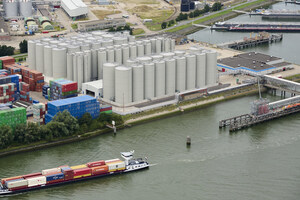Golden Agri-Resources Ends 2019 on a High Note
- Full year EBITDA grew by 22 percent to US$697 million while Underlying Profit achieved at US$272 million
- Increased contribution from downstream business to EBITDA resulted in stronger year-on-year results despite lower average CPO prices
- Proposed final dividend of 0.58 Singapore cents per share for full year 2019 performance, same with the previous year's distribution
Financial Highlights
US$'million |
Year ended 31 Dec |
Change |
Quarter ended |
Change |
||
2019 (FY 2019) |
2018 (FY 2018) |
31 Dec 2019 (4Q 2019) |
30 Sep 2019 (3Q 2019) |
|||
Revenue |
6,432 |
7,167 |
-10% |
1,702 |
1,563 |
9% |
Gross Profit |
831 |
1,007 |
-17% |
299 |
188 |
59% |
EBITDA[1] |
697 |
573 |
22% |
392 |
107 |
267% |
Underlying Profit[2] |
272 |
181 |
50% |
284 |
3 |
8673% or n.m |
Net Profit/(Loss)[3] |
194 |
(2) |
n.m |
240 |
0.8 |
n.m |
Earnings/(Loss) per Share[4] (US$ cents) |
1.56 |
(0.01) |
n.m |
1.92 |
0.01 |
n.m |
SINGAPORE, Feb. 28, 2020 /PRNewswire/ -- Golden Agri-Resources Ltd and its subsidiaries ("GAR" or the "Company") showed a robust performance ending the full year with EBITDA[1] at US$697 million, growing by 22 percent from last year with contribution from the downstream business at 57 percent. Underlying profit[2] increased by 50 percent to US$272 million in 2019.
Fourth quarter EBITDA[1] reached US$392 million supported by strengthening palm oil prices during the quarter and a net fair value gain of financial assets of US$214 million recorded in accordance with IFRS 9. Underlying profit[2] for the fourth quarter was also higher at US$284 million.
This performance was achieved despite a ten percent lower revenue of US$6.43 billion in 2019. Weaker CPO market prices and plantation output continued to impact revenue. CPO market prices (FOB Indonesia) averaged US$523 per tonne during 2019, a decrease of seven percent compared to the previous year.
Mr. Franky O. Widjaja, GAR Chairman and Chief Executive Officer commented on the results: "I am pleased to see GAR close the year with improved results despite the weak CPO price in 2019. Prices strongly rebounded towards the end of the year supported by a tightening supply and demand situation. Supply growth in 2020 is expected to slow down further given dry weather conditions last year, while demand will be boosted by the B30 biodiesel mandate implementation in Indonesia. While we believe that the strong CPO price trend will continue, the appearance of the COVID-19 epidemic in China is a new risk factor. While we continue to monitor development of the outbreak closely, we expect the impact on palm oil demand to be modest and short term."
For GAR's 2019 performance, the Board proposes a final dividend of 0.58 Singapore cents per share or approximately US$55 million in total, representing 20 percent of underlying profit[2]. The proposed dividend will be distributed on 18 May 2020 subject to approval from GAR's shareholders at the Annual Meeting.
Segmental Performance
Plantations and Palm Oil Mills
As at 31 December 2019, GAR's planted area stood at 498 thousand hectares, of which 21 percent owned by plasma smallholders. The accelerated replanting of old estates totalled 17,200 hectares in 2019, bringing down the average age of trees to 16 years. The new estates use next-generation, higher yielding planting materials, and are designed to accommodate future mechanisation to improve efficiency and reduce cost.
Fourth quarter 2019 fruit yield reached 5.8 tonnes per hectare, leading to full year yield of 21.5 tonnes per hectare. Harvested fruits for full year 2019 totalled 9.9 million tonnes, which was processed into over 2.9 million tonnes of palm products. Subsequent to a bumper crop in 2018, palm product output moderated by four percent during the year, also impacted by dry weather conditions and the replanting programme.
Upstream quarterly EBITDA[1] improved significantly to US$132 million with the rebound in CPO prices towards end of the year, contributing to full year EBITDA[1] of US$299 million. Despite lower average CPO market prices and plantation output, 2019 EBITDA margin remained robust at 23 percent. The EBITDA of this segment includes the allocated net fair value gain on financial assets.
Palm, Laurics and Others
Our downstream segment mostly consists of the processing and merchandising of palm and oilseed based products comprising bulk and branded products, oleo-chemicals and other vegetable oils, as well as production and distribution of other consumer products in China and Indonesia.
The palm, laurics and others segment generated revenue of US$6.4 billion during 2019, ten percent lower than last year due to lower selling prices. However, segmental EBITDA[1] reached US$398 million, more than double from last year and translating to a margin of 6.2 percent. This performance was contributed primarily by biodiesel and destination sales. The EBITDA[1] also includes higher allocated net fair value gain on financial assets. With GAR's integrated business model, the contribution of downstream business to total consolidated EBITDA[1] expanded to 57 percent from 32 percent last year.
[1] Earnings before tax, non-controlling interests, interest on borrowings, depreciation and amortisation, net gain or loss from changes in fair value of biological assets, foreign exchange gain or loss, and exceptional items. |
[2] Net profit attributable to owners of the Company, excluding net effect of net gain or loss from changes in fair value of biological assets, depreciation of bearer plants, exceptional items, foreign exchange gain or loss, and deferred tax expense. |
[3] Net profit/loss attributable to owners of the Company. |
[4] Earnings/loss per share is net profit or loss attributable to owners of the Company divided by weighted average number of shares. |







Share this article